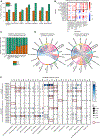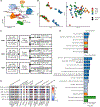Single-nucleus RNA sequencing in ischemic cardiomyopathy reveals common transcriptional profile underlying end-stage heart failure
- PMID: 36790929
- PMCID: PMC10423750
- DOI: 10.1016/j.celrep.2023.112086
Single-nucleus RNA sequencing in ischemic cardiomyopathy reveals common transcriptional profile underlying end-stage heart failure
Abstract
Ischemic cardiomyopathy (ICM) is the leading cause of heart failure worldwide, yet the cellular and molecular signature of this disease is largely unclear. Using single-nucleus RNA sequencing (snRNA-seq) and integrated computational analyses, we profile the transcriptomes of over 99,000 human cardiac nuclei from the non-infarct region of the left ventricle of 7 ICM transplant recipients and 8 non-failing (NF) controls. We find the cellular composition of the ischemic heart is significantly altered, with decreased cardiomyocytes and increased proportions of lymphatic, angiogenic, and arterial endothelial cells in patients with ICM. We show that there is increased LAMININ signaling from endothelial cells to other cell types in ICM compared with NF. Finally, we find that the transcriptional changes that occur in ICM are similar to those in hypertrophic and dilated cardiomyopathies and that the mining of these combined datasets can identify druggable genes that could be used to target end-stage heart failure.
Keywords: CP: Molecular biology; dilated cardiomyopathy; druggable genome; heart failure; hypertrophic cardiomyopathy; ischemic cardiomyopathy; single-nucleus RNA sequencing.
Copyright © 2023 The Authors. Published by Elsevier Inc. All rights reserved.
Conflict of interest statement
Declaration of interests C.A.K. is an employee of Bayer US LLC (a subsidiary of Bayer AG) and may own stock in Bayer. S.H., S.B., and C.A.K. were full-time employees of Bayer when this work was performed. P.T.E. has received sponsored research support from Bayer AG, IBM Health, Bristol Myers Squibb, and Pfizer; he has also served on advisory boards or consulted for Bayer AG, MyoKardia, and Novartis. K.B.M. has research grant funding from Amgen, USA and has also served on advisory boards for MyoKardia, Bristol-Myers Squibb, and Pfizer.
Figures






References
-
- Khan MA, Hashim MJ, Mustafa H, Baniyas MY, Al Suwaidi SKBM, AlKatheeri R, Alblooshi FMK, Almatrooshi MEAH, Alzaabi MEH, Al Darmaki RS, and Lootah SNAH (2020). Global epidemiology of ischemic heart disease: results from the global burden of disease study. Cureus 12, e9349. 10.7759/cureus.9349. - DOI - PMC - PubMed
-
- Fu X, Khalil H, Kanisicak O, Boyer JG, Vagnozzi RJ, Maliken BD, Sargent MA, Prasad V, Valiente-Alandi I, Blaxall BC, and Molkentin JD (2018). Specialized fibroblast differentiated states underlie scar formation in the infarcted mouse heart. J. Clin. Invest 128, 2127–2143. 10.1172/JCI98215. - DOI - PMC - PubMed
-
- Molenaar B, Timmer LT, Droog M, Perini I, Versteeg D, Kooijman L, Monshouwer-Kloots J, de Ruiter H, Gladka MM, and van Rooij E (2021). Single-cell transcriptomics following ischemic injury identifies a role for B2M in cardiac repair. Commun. Biol 4, 146. 10.1038/s42003-020-01636-3. - DOI - PMC - PubMed
Publication types
MeSH terms
Grants and funding
LinkOut - more resources
Full Text Sources
Medical
Miscellaneous

